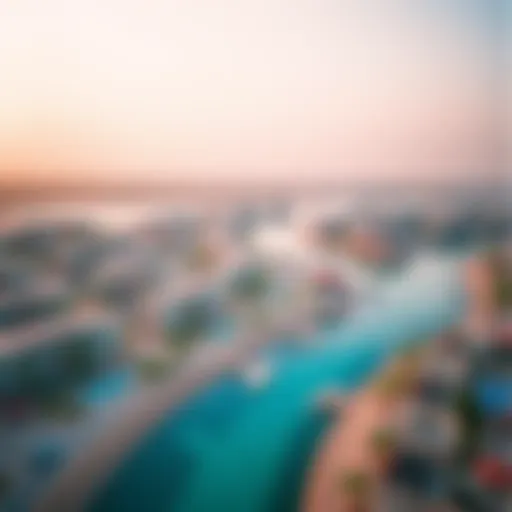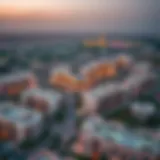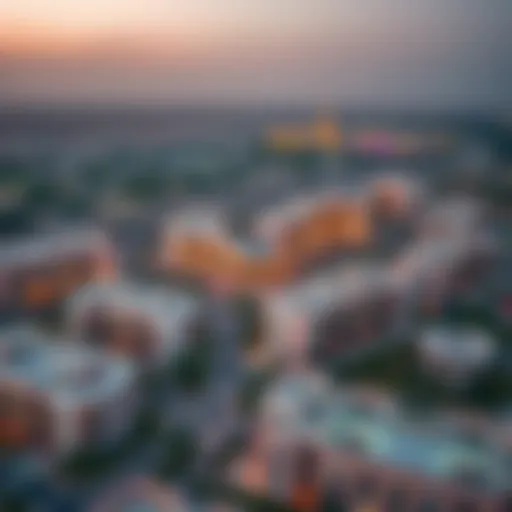Exploring Flat Prices in Burj Khalifa


Intro
The Burj Khalifa isn't just a centerpiece of Dubai’s skyline; it's also a significant player in the global real estate market. Understanding the pricing dynamics of flats in this iconic skyscraper is essential for anyone considering a purchase or investment. With prices often totttering around astronomical figures, potential buyers and investors need to grasp what drives these costs.
A blend of various influences, from location to luxury amenities, shapes what one might expect to invest. This article aims to provide a thorough exploration of how the market operates within the Burj Khalifa, shedding light on key trends, investment opportunities, and more.
Let's dive into the currents that are shaping the prices of flats in this architectural wonder.
Market Trends and Insights
Current Market Conditions
The real estate market in the Burj Khalifa remains a unique blend of luxury and exclusivity. As of 2023, we see a steady demand despite global economic fluctuations. Buyers are often wealthy individuals looking for not just a home but a lifestyle. Prices remain high, often due partially to the historical allure of living in one of the tallest buildings in the world.
In recent months, there has been an uptick in interest as international buyers seek second homes or investment properties in Dubai. High-end amenities, proximity to business hubs, and privileged views all play into the valuation of these flats. When considering a flat here, you might notice that many options come with high-tech features and luxurious interiors, translating into a higher price tag than other residential options.
Future Predictions and Projections
Looking ahead, the market for flats in the Burj Khalifa is expected to maintain its robust status, albeit with fluctuating interest based on global economic conditions. Analysts predict that with the ongoing development of Dubai as a major global city, prices may continue to rise steadily. Moreover, trends towards sustainable and smart living are becoming pivotal in shaping demand.
"Investing in flats within such an exclusive location is likely to remain a coveted opportunity, provided buyers understand market patterns and adjust their offers accordingly."
As new residential projects emerge in surrounding areas, investors may want to compare the Burj Khalifa flats with alternative options, like residences in Dubai Marina or Jumeirah, for potential better value.
Investment Opportunities
Emerging Neighborhoods
While the Burj Khalifa holds a crown with its prestige, emerging neighborhoods in Dubai increasingly grab investors’ attention. Areas like Downtown Dubai continue to blossom, presenting competitive options for luxury living with more attractive pricing. Not only do these neighborhoods offer proximity to major attractions, but they also introduce modern developments that attract new buyers.
Types of Properties to Invest In
Investing in properties at or near the Burj Khalifa doesn’t only include flats; a range of options exists for discerning investors. Consider:
- Luxury flats: These typically come with expansive views and high-end finishes.
- Penthouses: Offering exclusive spaces with panoramic views and lavish amenities.
- Mixed-use spaces: Increasingly popular, these properties might include retail outlets or offices, adding to their investment appeal.
Each type carries its unique benefits and appeals to varied segments of the market, ensuring that prospective investors can find an option that matches their goals.
By navigating through the nuances of pricing and understanding the broader context of market trends, potential investors can position themselves effectively in the competitive landscape surrounding the Burj Khalifa. Armed with insights into local conditions, buyers can make informed decisions about their real estate endeavors.
Overview of Burj Khalifa
The Burj Khalifa, towering at a staggering 828 meters, isn't just a structure; it represents a dazzling blend of innovation, ambition, and cultural pride. This iconic skyscraper isn't merely a backdrop for stunning Dubai sunsets; it is a prime location where luxury living meets unbeatable views. Understanding the significance of this building is vital for anyone diving into the real estate market here.
Having been completed in 2010, the Burj Khalifa quickly carved out its place in architectural history. Set against the Arabian Desert, it attracts visitors and residents alike, eager to experience its grandeur. With a prime location, towering above the skyline, the flats in this building offer an enticing arrangement of luxury and convenience, attracting wealthy investors and homebuyers from around the globe.
Historical Context
When discussing the history of the Burj Khalifa, it's crucial to understand its inception. Designed by the renowned architect Adrian Smith from the firm Skidmore, Owings & Merrill, the project aimed to revamp the area around the Dubai Creek. The construction started in 2004, amidst financial uncertainty, but it was the strategic vision of the Dubai government that kept this ambitious project afloat. After years of hard work and challenges, including a few delays, the Burj Khalifa was officially opened on January 4, 2010.
Since then, it has reshaped the narrative of skyscrapers worldwide and become a symbol of growth and determination for the emirate. Dubai wanted to showcase not only monumental architecture but also draw in tourism and business. The sheer scale of the building signifies an era where the impossible became feasible, effectively changing perceptions of urban living.
Architectural Significance
The architectural prowess of Burj Khalifa makes it a case study in modern design and engineering. Its Y-shaped plan optimizes views of the surrounding landscapes, ensures maximum sunlight, and minimizes wind forces, making it stable even in the famous desert winds. This innovative design cleverly draws inspiration from the Islamic architecture seen across the Middle East, demonstrating both cultural appreciation and advancement.
Moreover, the tower is adorned with high-quality materials, setting a standard for luxury in the construction industry. The exterior is clad in reflective glazing and embellished with advanced insulating technology, enhancing energy efficiency.
"The Burj Khalifa exemplifies how architecture can be both functional and an expression of creativity. Each detail considered, each feature serves a purpose beyond mere aesthetics."
Current Market Trends for Flats
In the ever-evolving landscape of real estate, the market trends for flats in Burj Khalifa serve as a litmus test for luxury living in Dubai. Recognizing these trends isn't merely an academic exercise; it’s a crucial step for investors, buyers, and real estate professionals aiming to navigate this opulent domain. While the allure of residing in one of the tallest structures globally is undeniable, understanding the pricing dynamics is equally important.
The current market trends reveal a fascinating interplay of demand, supply, and buyer sentiment. As the repercussions of global economic shifts ripple through the property sector, it becomes imperative to unpack how these factors influence the desired flats in Burj Khalifa. Staying abreast of where the tide is turning can illuminate opportunities and potential pitfalls for prospective buyers.
Recent Price Developments
In the last few years, the price trajectory of flats in Burj Khalifa has shown remarkable resilience, even amidst economic fluctuations. As of late 2023, one-bedroom units typically command anywhere between AED 2.5 million to AED 4 million, while those seeking larger options can expect to pay upwards of AED 6 million for multi-bedroom residences. The sharp end of the spectrum often features luxury penthouses, with some listings surpassing AED 30 million, catering to a select group who can afford sky-high living.
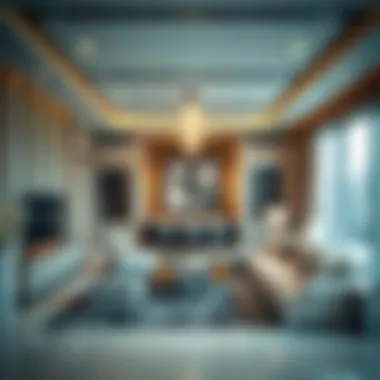

Prices have seen sporadic hikes, often coinciding with events like Expo 2020 and the ongoing recovery from the COVID-19 pandemic, which spurred interest in unique spaces. It is not unusual to see price adjustments linked to market sentiment, while trends in occupancy rates for these flats also play a role in how pricing behaves over time. A growing interest from international buyers looking for safe havens solidifies this trend, providing a counterweight to local economic uncertainties.
It’s essential to note that while the prices are robust, they differ based on various parameters, including the view, floor level, and the specific amenities within each flat. Therefore, potential buyers must assess their desired attributes carefully.
Buyer Demographics
The profile of individuals investing in Burj Khalifa flats is as diverse as its architectural design. A mix of locals, expatriates, and affluent international buyers contribute to a uniquely dynamic market. Many of these buyers are attracted not just by the luxury lifestyle that Burj Khalifa offers, but by the sound prospects for appreciation in property value.
Research indicates that the demographic lean heavily towards the affluent upper class, with many buyers hailing from regions such as Europe, Asia, and North America. These buyers are often in search of both primary residences or investment properties, aiming for a slice of the luxury pie. Notably, buyers from India, the UK, and China show a particular interest, driven by both lifestyle aspirations and investment strategies.
Another interesting aspect is the trend of younger buyers, such as millennials and Gen Z, who are becoming increasingly interested in urban living and premium lifestyles, despite not being traditional luxury buyers. They are generally attracted to the vibrant social scene and easy access to fine dining, entertainment, and cultural attractions around the city center.
Understanding these buyer demographics helps shape marketing strategies for real estate agents and developers. It also allows potential investors to tailor their offers and expectations when engaging in the market. Being aware of who is likely to buy what can bolster discussions around pricing and future investment opportunities.
"The pricing trends of flats in Burj Khalifa reflect more than just numbers; they tell a story of ambition, luxury, and evolving buyer interests."
Factors Influencing Price
When considering the price of flats in the Burj Khalifa, a myriad of factors comes into play that collectively shapes the financial landscape and valuation of properties within this extraordinary edifice. Understanding these elements is paramount for potential investors, homebuyers, and even real estate agents who aim to navigate the intricate environment of luxury property.
The location's prime status, the availability of upscale amenities, and the balance of market demand against supply can drastically influence pricing. Such factors not only determine the initial prices but also affect the long-term investment potential. Each aspect modifies the overall buyer experience and impacts how flats are perceived in a market flooded with options.
Location and Accessibility
The Burj Khalifa stands tall in Downtown Dubai, a pulsating hub characterized by its close proximity to essential services and attractions like The Dubai Mall and the Dubai Fountain. Such central positioning carries significant weight in shaping property values.
Accessibility is another crucial factor. The ease with which residents can access business centres, schools, shopping areas, and entertainment venues adds considerable value to the flats. Prospective buyers often weigh the convenience of transport links against other variables. For example, having a direct route via the Dubai Metro can substantially uplift desirability and, naturally, the price as well.
- Proximity to key locales
- Direct public transport links
- Vibrant community life
This intricate web of location benefits makes real estate in Burj Khalifa not just a residence but a holistic lifestyle choice. Buyers are often willing to pay a premium for such integrated living experiences.
Amenities and Services
Another significant piece of the puzzle is the list of amenities that come with owning a flat in the Burj Khalifa. Modern buyers are not just looking for a place with four walls and a roof; they want a lifestyle replete with comfort and luxury. The availability of high-end amenities such as swimming pools, fitness centres, and concierge services can sway prospective owners into making a purchase that otherwise might have seemed exorbitant.
Flats in Burj Khalifa offer residents access to:
- Spa facilities and wellness services
- World-class dining options within the tower
- Business lounges and conference rooms
These luxuries contribute to a more desirable living environment, thereby acting as a catalyst for higher pricing. When amenities are in abundance, the resultant exclusivity justifies the price tag attached.
Market Demand and Supply
In any market, the basic principles of demand and supply hold firm. The Burj Khalifa is an iconic structure that inherently piques interest among buyers, both domestic and international. High demand often translates to higher prices. This is particularly true for particular units that offer spectacular views or unique layouts. Yet, the tower’s various available flats provide a mix that can cater to different price points, complicating the market dynamics.
A few points worth considering include:
- Seasonal fluctuations in buyer interest
- Number of available units versus buyer inquiries
- Impact of broader economic conditions on luxury real estate
> The blend of limited supply and high demand perpetuates a cycle where prices constantly reflect the market's pulse.
In essence, prospective buyers need to consider all these factors holistically. Understanding the nuances can empower them to make informed decisions when it comes to investing in a flat in one of the world’s most recognizable buildings.
Types of Flats Available
The Burj Khalifa is not just a prominent piece of architecture but also a unique real estate opportunity, offering diverse flat options that cater to a variety of preferences and budgets. Understanding these types of flats is crucial for potential investors and homebuyers as it aids in making informed choices based on lifestyle expectations, financial capabilities, and long-term goals. Each type of flat serves specific needs, whether one is looking for a cozy starter home or a lavish penthouse. In this section, we will explore the array of options available, highlighting their characteristics, benefits, and factors to consider when selecting a residence in this iconic structure.
Studios and One-Bedroom Units
Studios and one-bedroom units present a practical choice for singles or young couples interested in the vibrant lifestyle that the Burj Khalifa offers. These units typically range from 450 to 900 square feet, showcasing efficient layouts designed to maximize space and comfort.
Key Features:
- Compact Living: Perfect for minimalists or those frequently travel.
- Amenities Access: Residents benefit from the luxurious amenities like pools, gyms, and lounges within the building, making life convenient and enjoyable.
- Investment Value: These smaller units are often more affordable, attracting young professionals and renters keen on immersive urban living.
However, potential buyers should assess their lifestyle needs. For instance, though smaller in size, the views from these units can be spectacular, enhancing the living experience.
Two and Three-Bedroom Units
Moving up in size, the two and three-bedroom units cater to families or those wanting more space for guests or home offices. These flats usually range from 1,200 to over 2,000 square feet, blending luxury with functionality.
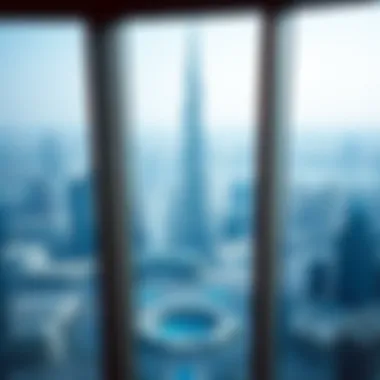

What to Consider:
- Flexibility: More bedrooms offer the option to convert spaces for various purposes, such as home offices or guest rooms.
- Family-Friendly Features: These apartments often come with larger living areas and multiple bathrooms, accommodating family needs more comfortably.
- Rental Appeal: Given their spacious layout, these units tend to attract families looking for longer-term rentals or investments, leading to favorable rental yields.
Families should also pay attention to potential noise levels, as proximity to common areas could be a factor, but the overall luxury setting often compensates for it.
Luxury Penthouses
At the pinnacle of exclusivity are the luxury penthouses. These lavish retreats represent the epitome of living in the clouds, often boasting staggering square footage and breathtaking, unparalleled views of the city and beyond.
Highlights Include:
- Opulent Features: Many come with private elevators, expansive terraces, swimming pools, and premium finishes that define luxury living.
- Privacy and Space: Ideal for high-net-worth individuals seeking privacy and bespoke living experiences.
- Status Symbol: Owning a penthouse isn’t just about luxury; it’s a prestigious statement that can enhance social standing.
Investors eyeing these units should be prepared for a significant investment. It’s important to evaluate not just the price but also future resale value, as the market for luxury flats can fluctuate.
Investment Potential
The investment potential of flats in Burj Khalifa is a topic that carries much weight in the real estate landscape of Dubai. As the tallest building in the world, the Burj Khalifa stands not just as an architectural feat, but also as a beacon for investors seeking stability and growth in their portfolios. The combination of luxury living and the stature of the property offers a unique opportunity for both long-term homeowners and investors alike.
This section will dive into two crucial aspects that help understand the investment potential: the rental yield analysis and long-term appreciation trends. Knowing how and why these elements are significant will empower potential buyers to make worthwhile decisions.
Rental Yield Analysis
When it comes to investing, understanding rental yields is essential. In the prime location of the Burj Khalifa, the rental yields are typically higher than average, making it an attractive prospect for landlords. Investors interested in generating income will find that the demand for rentals in such a landmark is resilient and steady.
To put things into perspective, rental income from a one-bedroom apartment can yield an average return of about 6-7%. This is notable especially when compared to other upscale developments in Dubai and even globally. However, it doesn't stop at just the percentage; the actual demand for rental spaces in such a prestigious location infers a consistent flow of tenants who are willing to pay a premium.
Some of the following factors bolster this rental yield potential:
- Tourist Attraction: Being part of a tourist hotspot increases foot traffic and potential short-term rental arrangements.
- Corporate Contracts: Companies often seek high-end residences for their expatriate employees, driving demand for rental units.
- Quality Amenities: The high-quality amenities provided within the Burj Khalifa increase tenant satisfaction and retention.
In essence, potential investors can expect a reliable rental income stream if they purchase a unit in Burj Khalifa, making it a prudent consideration for many investors.
Long-term Appreciation
Long-term appreciation is the cherry on top for any property investor. Flats in Burj Khalifa have not only held their value over time but have shown a consistent appreciation rate. Investing in a property here is more than just securing a roof over one’s head; it’s acquiring an asset that may grow in value as time progresses.
Historical data shows that properties in iconic buildings, like the Burj Khalifa, tend to appreciate at a rate substantially higher than more standard residential areas. Factors contributing to this trend include:
- Historical Significance: The Burj Khalifa, since its inception, is perceived as an iconic structure. This status ensures continual demand as new generations see value in owning property in such storied buildings.
- Limited Supply: As the saying goes, there’s only one Burj Khalifa. The limited availability of flats means that even a small uptick in demand can lead to significant price increases.
- Economic Stability: Dubai's effort to bolster its economy, particularly in tourism and international business, makes the long-term outlook for property owners quite positive.
Comparative Market Analysis
The Comparative Market Analysis (CMA) is a vital piece in the puzzle of understanding the pricing of flats in the Burj Khalifa. This approach leverages comparisons with similar properties, offering insights that aren't only quantitative but also qualitative. By examining how Burj Khalifa's pricing stacks up against other high-end developments, potential investors and buyers can gain a much clearer picture of their options.
In the arena of real estate, especially in a premium market like Dubai, pricing doesn't just tell you how much a unit costs; it reflects a myriad of underlying factors such as demand, desirability, and unique features of each property. Therefore, conducting a thorough CMA serves multiple purposes:
- Understanding Perceived Value: Buyers often assess properties based on what they can expect in return. By looking at similar luxury developments, one can ascertain whether a flat in the Burj Khalifa offers a premium that aligns with its iconic status.
- Pricing Strategy: Sellers looking to list their flats must craft a strategy that considers prevailing market trends. Knowing how similarly priced properties in comparable locales have performed aids in making financial decisions.
- Investment Viability: For investors, evaluating the Burj Khalifa against other luxury buildings helps in determining potential appreciation over time. Tracking historical performance trends can guide future investments.
Burj Khalifa vs. Other Luxury Developments
When placing Burj Khalifa beside other luxurious residential complexes, it’s essential to consider not only the flat prices but also what accompanies these prices—location, amenities, and market positioning. Buildings such as The Address downtown or the Emirates Towers may attract a similar clientele, but Burj Khalifa carries an unparalleled brand. The sheer height and visibility, coupled with its status as the tallest building in the world, contribute to both its allure as well as its desirability.
While other luxury developments might offer high-end finishes and fine amenities, few match Burj Khalifa’s architectural marvel and global recognition. The unparalleled view from the observation deck or the exclusivity of being in such a renowned landmark is hard to replicate.
In comparing specifics, consider factors like:
- Accessibility: How easily can residents reach workplaces, malls, or other attractions?
- Amenities: While many luxury buildings feature pools and gyms, the Burj Khalifa’s amenities include a spa, fine dining, and even a full-floor outdoor pool area.
- Community Feeling: Many luxury developments strive for a sense of community through features like guest lounges or event spaces, fostering connections among residents.
Pricing Variances by Floor Level
An often-overlooked element in the pricing strategy of flats in the Burj Khalifa is the floor level. Typically, as one moves higher up the building, the price per square foot increases significantly. This is primarily due to the views and exclusivity associated with higher floors. Investors and buyers are often keen to know how the floor level impacts pricing as they contemplate the best investment.
- Penthouse Prices: The top-most levels offer unparalleled views and luxury, commanding premium prices due to their limited availability and unique perks such as spacious living areas and expansive balconies.
- Mid-Level Units: These are often more accessible, providing good views while being slightly more affordable than the upper floors. However, they still see a rise in value over time.
- Low-Level Pricing: Apartments located closer to the ground may include more accessible pricing, but they often lack the panoramic views that many buyers seek.
Thus, in addition to competing with peer luxury developments, the floor level also establishes an internal hierarchy of price increments. This informs buyers not only about what they will pay but also about what value they will receive over time.
Ultimately, understanding these nuances through a robust comparative market analysis allows buyers and investors to navigate the complexities of the Burj Khalifa’s pricing effectively, ensuring each party enters the market equipped with knowledge and insight.

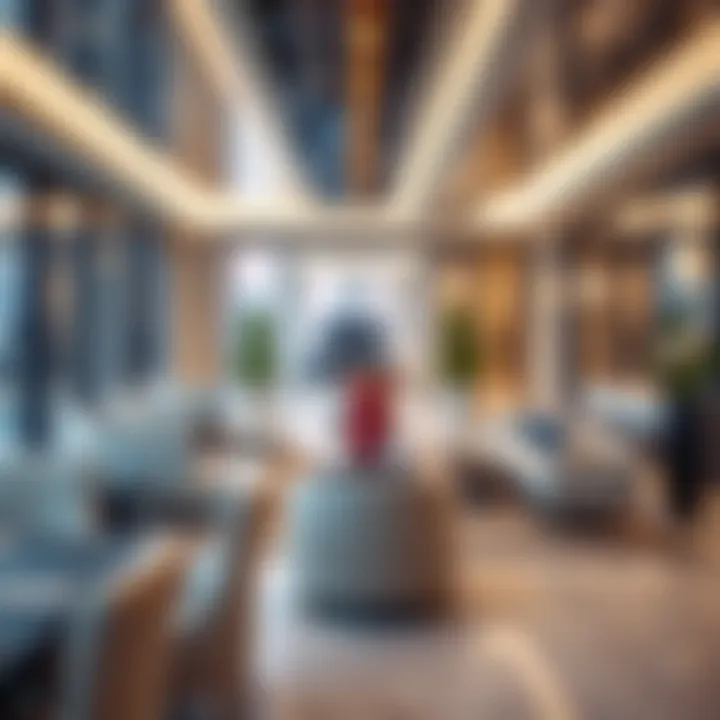
Legal Considerations
Understanding the legal landscape when purchasing a flat in the Burj Khalifa is essential for potential investors and homebuyers. It influences not only the process of acquiring the property, but also its long-term ownership and value. Navigating through the myriad of regulations and compliance measures in Dubai is crucial for a sound investment.
Property Ownership Regulations
Dubai's property ownership laws are unique and can sometimes feel overwhelming. For instance, foreigners are generally allowed to own property in designated areas, including the Burj Khalifa. This is a significant factor that has attracted international buyers. However, there are crucial guidelines to bear in mind:
- Freehold vs. Leasehold: The Burj Khalifa has areas where freehold ownership is permitted, allowing complete ownership of property. Conversely, in leasehold areas, ownership is limited to a specific period, typically 99 years.
- Ownership Documents: Prospective owners must secure a title deed, indicating ownership and confirming the right to sell or lease the property in the future. Without these documents, one may find themselves in a precarious situation.
- Regulatory Approvals: Transactions are overseen by the Dubai Land Department, which mandates that all paperwork be submitted accurately and within the required timelines. Failure to comply can result in hefty fines and delays in the transfer process.
By ensuring adherence to these regulations, buyers can protect their investments and enjoy the benefits of ownership without legal headaches.
Tax Implications for Buyers
When it comes to owning a flat in one of the world’s most iconic buildings, understanding tax implications is another critical element that can influence purchase decisions. It's not just about the price tag of the flat; it's also about what comes next. Here are a few insights into the tax landscape in Dubai:
- No Property Tax: One of the most attractive features of real estate in Dubai is the absence of property taxes. This can significantly enhance the profitability of owning a flat in the Burj Khalifa, as ongoing costs are fre from such obligations.
- Transaction Fees: Buyers should prepare for the associated fees when purchasing property. For instance, the Dubai Land Department typically charges a transfer fee of 4% of the property's value, which can add a significant sum to the initial cost.
- Value Added Tax (VAT): While residential properties are generally exempt from VAT, if the property is being purchased as a commercial investment or if it’s leased to tenants, VAT may apply under certain circumstances.
It’s imperative for buyers to consult with a tax advisor to ensure they are fully aware of their obligations. Keeping abreast of the legal and tax systems helps one navigate the complexities of the Dubai real estate market effectively.
"Knowledge of legal considerations and tax implications can save investors from potential pitfalls in Dubai's vibrant real estate market."
Understanding these nuances not only empowers buyers but can also enhance their real estate portfolio's value, particularly in a prestigious location like the Burj Khalifa.
Financing Options
When considering the purchase of a flat in Burj Khalifa, understanding the available financing options is paramount. This aspect not only affects the affordability of the property but also has a significant impact on prospective buyers’ ability to make informed investment decisions. Given Burj Khalifa’s stature as one of the world’s most iconic skyscrapers, the financial avenues to own a piece of this architectural wonder require thorough examination.
Mortgage Availability
One of the most common pathways for individuals looking to invest in a property is through a mortgage. Lenders often have different criteria and processes when it comes to financing luxury real estate. In the context of Burj Khalifa, mortgage options typically include both fixed-rate and adjustable-rate plans. Fixed-rate mortgages provide predictability with consistent payments over the life of the loan, while adjustable-rate mortgages may start off lower but can fluctuate, depending on market conditions.
Furthermore, many banks and financial institutions in the UAE have specific programs catered to expatriates, recognizing that many buyers in Burj Khalifa are foreign investors looking for either personal residences or profitable rental opportunities. It’s also worth noting that lenders may require a larger down payment for high-value properties such as those in this skyscraper, often ranging from 25% to 40% of the purchase price.
Alternative Financing Solutions
In addition to traditional mortgages, buyers can explore alternative financing solutions. One notable approach involves bridging loans, which allow purchasers to secure funding quickly, especially advantageous in a competitive market like Burj Khalifa where properties can be sold in a snap.
Another option is utilizing a real estate investment trust (REIT). This can make it easier for potential investors to pool resources with others, allowing for the purchase of a unit without having to bear the whole cost alone.
Personal loans are also an avenue worth considering, though they often come with higher interest rates compared to mortgages. This option might be viable for those requiring quick cash for down payments or closing costs.
In essence, navigating the financing landscape requires an understanding of various options, looking beyond the traditional routes. Having a solid grasp of these choices allows buyers not only to optimize their investments but also to make strategic decisions that align with their financial goals.
"Making informed financial choices is as crucial as selecting the right property, especially in prestigious real estate like Burj Khalifa."
The complexities of financing in such a unique market necessitate careful planning and often consultative guidance from financial experts.
For more detailed guidance on financing options and mortgage availability in the UAE, you may visit Emirates NBD, or refer to resources at Dubai Land Department.
Understanding these facets of financing will empower potential buyers, enabling them to navigate the nuances of investing in a flat at Burj Khalifa with confidence.
Closure
Understanding the price dynamics of flats in the Burj Khalifa isn’t merely an academic exercise; it’s crucial for anyone considering investing in this iconic structure. The importance of this conclusion lies in summarizing the vital aspects of purchasing in this market. Prospective buyers benefit from grasping the intricate balance between location, luxury amenities, and investment potential that Burj Khalifa offers. This blend creates a unique opportunity for those looking to invest not just in a flat, but a lifestyle.
Investors need to approach this market with their eyes wide open, recognizing that high prices come with high expectations. Not only does one enjoy unparalleled views and architectural brilliance, but the prestige associated with living in such a renowned landmark is itself a commodity.
When discussing key elements like rental yields and historical price patterns, it becomes clear why purchases made here are more than just real estate transactions; they are investments in a legacy. Furthermore, understanding the fluctuating market trends gives buyers a clear picture of current competitive pricing, leading to more informed and strategic investment decisions.
Summary of Key Insights
In this examination, some insights have emerged that resonate across the board for potential buyers:
- Pricing Trends: Prices continue to fluctuate based on global economic factors, yet premium units maintain their value consistently due to their unique status.
- Investment Value: High rental yields coupled with the brand value of Burj Khalifa present significant opportunities, especially for long-term investors looking for high-return assets.
- Target Demographics: The buyer demographics indicate a mix of affluent locals and international investors, diversifying the demand pool and strengthening the market.
Ultimately, each insight serves as a building block for a clearer understanding of what it means to invest in property within the Burj Khalifa.
Future Market Outlook
Looking ahead, the prospects for pricing in the Burj Khalifa remain intriguing, shaped by both local economic conditions and global trends. As Dubai continues to push the envelope in luxury living and tourism, factors such as:
- Sustainable Development: The global shift toward sustainable living is likely to influence future developments in the area, potentially modifying pricing structures.
- Tourism Trends: With Dubai's tourism projected to grow steadily, demand for premium units can be expected to increase, thus driving up prices in the long run.
- Global Economic Factors: Economic fluctuations and geopolitical dynamics will continue to affect investor confidence, thus impacting the real estate market.
"Investment in Burj Khalifa isn't just about acquiring real estate; it's about owning a piece of modern history."
As these influences come into play, staying informed and agile will be paramount for investors, homebuyers, and industry professionals alike.



